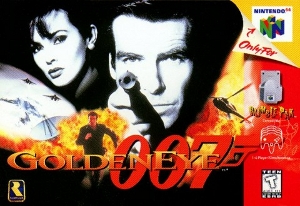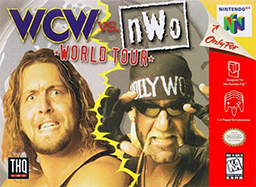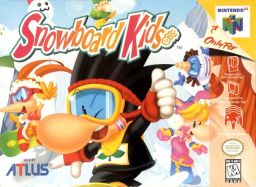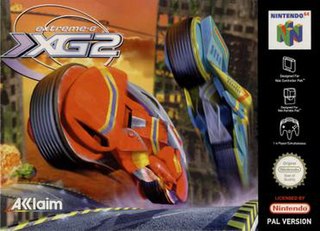
GoldenEye 007 is a 1997 first-person shooter video game developed by Rare and published by Nintendo for the Nintendo 64. Based on the 1995 James Bond film GoldenEye, the player controls the secret agent James Bond to prevent a criminal syndicate from using a satellite weapon. They navigate a series of levels to complete objectives, such as recovering or destroying objects, while shooting enemies. In a multiplayer mode, up to four players compete in several deathmatch scenarios via split-screen.

Perfect Dark is a 2000 first-person shooter developed and published by Rare for the Nintendo 64. The first game of the Perfect Dark series, it follows Joanna Dark, an agent of the Carrington Institute research centre, as she attempts to stop an extraterrestrial conspiracy by rival corporation dataDyne. The game features a campaign mode where the player must complete a series of levels to progress through the story, as well as a range of multiplayer options, including a co-operative mode and traditional deathmatch settings with computer-controlled bots.

Star Fox 64, known as Lylat Wars in the PAL regions, is a 1997 3D rail shooter video game developed and published by Nintendo for the Nintendo 64. It is the second installment in the Star Fox series and a reboot of the original Star Fox for the Super Nintendo Entertainment System.

Turok: Dinosaur Hunter is a first-person shooter video game developed by Iguana Entertainment and published by Acclaim for the Nintendo 64 console and Microsoft Windows. It was released in 1997 in North America and Europe. Turok is an adaptation of the Valiant Comics comic book series of the same name. The player controls Turok, a Native American warrior, who must stop the evil Campaigner from conquering the universe with an ancient and powerful weapon.

The World Is Not Enough is a first-person shooter video game developed by Eurocom and based on the 1999 James Bond film of the same name. It was published by Electronic Arts and released for the Nintendo 64 on October 17, 2000, shortly before the release of its PlayStation counterpart. The game features a single-player campaign in which players assume the role of secret agent James Bond as he fights to stop a terrorist from triggering a nuclear meltdown in the waters of Istanbul. It includes a split-screen multiplayer mode where up to four players can compete in different types of deathmatch and objective-based games.

Wipeout 64 is a 1998 futuristic racing game developed by Psygnosis and published by Midway for the Nintendo 64. It is the third game in the Wipeout series and remains the only one published on a Nintendo console. At the time of the game's release, developer Psygnosis had been owned for five years by Sony Computer Entertainment, for whose hardware all subsequent Wipeout games have been released exclusively.

Turok 2: Seeds of Evil is a first-person shooter video game developed by Iguana Entertainment and published by Acclaim Entertainment. It was released for the Nintendo 64 console in 1998 and ported to Microsoft Windows computers in 1999. Seeds of Evil is the second game in the Turok video game series and a sequel to Turok: Dinosaur Hunter. The game follows the story of a Turok and his efforts to stop a powerful alien entity from escaping the confines of his Lightship. A different game set in the same fictional universe, also titled Turok 2: Seeds of Evil, was released for the Game Boy Color alongside the Nintendo 64 game.

WCW vs. nWo: World Tour is a professional wrestling video game released in 1997 for the Nintendo 64 game console. Released at the peak of World Championship Wrestling's (WCW) dominance in the Monday Night War, World Tour was THQ's first foray into the N64 wrestling scene and is a semi-sequel to the lesser known WCW vs. the World for the PlayStation. It is the second best-selling wrestling game for the N64 console.

Turok 3: Shadow of Oblivion is a first-person shooter video game developed by Acclaim Studios Austin and published by Acclaim Entertainment. It was released for the Nintendo 64 video game console in 2000. Shadow of Oblivion is the third main installment of the Turok series and a sequel to Turok 2: Seeds of Evil. The game received generally favorable reviews from critics. A separate game, also titled Turok 3: Shadow of Oblivion, which is set in the same universe but follows a different storyline, was released for the Game Boy Color in 2000. A remastered version of the game developed by Nightdive Studios released on November 30, 2023 for Nintendo Switch, PlayStation 4, PlayStation 5, Windows, Xbox One, and Xbox Series X/S.

Star Wars Episode I: Racer is a 1999 racing video game based on the podracing sequence in the film Star Wars: Episode I – The Phantom Menace. The game features all of the racers and race course on Tatooine from The Phantom Menace. It adds several new courses, on Tatooine and various planets. It has several single player modes, including a tournament mode. The format of multiplayer mode varies by platform. Jake Lloyd and Lewis MacLeod, who portrayed Anakin Skywalker and Sebulba in The Phantom Menace, reprise their film roles in the game.

Snowboard Kids, is a snowboarding video game for the Nintendo 64. It was developed by Racdym and published by Atlus. Many reviewers compared its style to that of the Mario Kart series. An enhanced port, Snowboard Kids Plus, was released in Japan in January 1999 for the PlayStation.

Kirby 64: The Crystal Shards is a 2000 platform game developed by HAL Laboratory and published by Nintendo for the Nintendo 64 (N64). It is the first Kirby game to feature 3D computer graphics and follows Kirby as he attempts to reassemble a sacred crystal shattered by Dark Matter. Gameplay is viewed from a 2.5D perspective and is similar to previous Kirby titles; the player traverses levels and obtains powers by eating enemies. Kirby 64 introduces Power Combos, the ability to mix powers to create more powerful ones. In a multiplayer mode, up to four players can compete in three minigames.

WWF War Zone is a professional wrestling video game developed by Iguana West and released by Acclaim Entertainment in 1998 for the PlayStation, Nintendo 64, and Game Boy. The game features wrestlers from the World Wrestling Federation.

Extreme-G 2, also known as Extreme G: XG2, is a racing video game developed by Probe Entertainment and published by Acclaim Entertainment for Nintendo 64 and Microsoft Windows. It is the sequel to Extreme-G and is followed by Extreme-G 3.

South Park is a first-person shooter video game based on the American animated sitcom of the same name. The game was developed by Iguana Entertainment, using a modified version of the engine used in the Acclaim Entertainment-published Turok 2: Seeds of Evil; both games shared the same publisher and were released for the Nintendo 64 in 1998 in North America, and for Microsoft Windows in 1999. South Park was released in Europe and ported to the PlayStation in the latter year to coincide with the film South Park: Bigger, Longer & Uncut.

South Park Rally is a 2000 kart-style racing video game based on the American animated sitcom South Park published by Acclaim Entertainment and released for the PlayStation, Microsoft Windows, Nintendo 64, and Dreamcast. Gameplay follows the player in a competitive racing championship set in the fictional town of South Park. Players are given the options for multiplayer, arcade, or championship modes, but only the championship unlocks extra features. Competition begins in South Park's 1st Rally, a circuit race around four checkpoints in the downtown area of South Park. Races get gradually more diverse, with more locations, racers, and elements added as the game progresses.

Armorines: Project S.W.A.R.M., known as Armorines in Europe, is a 1999 first-person shooter developed by Acclaim Studios London and released for the Nintendo 64, Game Boy Color and PlayStation. It is based on the Armorines comic book from Valiant Comics, which was bought by Acclaim Entertainment.

Perfect Dark is a 2000 action game developed and published by Rare for the Game Boy Color. As a direct prequel to its Nintendo 64 counterpart, the game follows agent Joanna Dark as she completes her training at the Carrington Institute research centre and uncovers information against rival corporation dataDyne. The gameplay revolves around shooting opponents and completing objectives such as rescuing hostages or recovering items. The game also includes a multiplayer mode where two players may compete against each other in several deathmatch modes.

Turok 2: Seeds of Evil is an action-platform video game developed by Bit Managers and published by Acclaim Entertainment. It was released for the Game Boy Color handheld game console in 1998 alongside its Nintendo 64 counterpart. The game is backward compatible with the original Game Boy in monochrome mode. Although the game is set in the same world as its counterpart, it features a different storyline.

Turok: Rage Wars is an action video game developed by Bit Managers and published by Acclaim Entertainment for the Game Boy Color handheld console in 1999. Although the game is set in the same universe as its Nintendo 64 counterpart, it is a different game. The game received generally favorable reviews from critics.




















